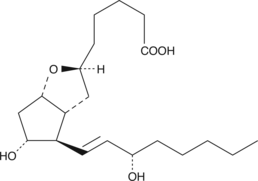Chemicals
Showing 7051–7200 of 41137 results
-
The Ras family of small GTPases (H-Ras, K-Ras, and N-Ras) function as molecular switches, cycling between a GTP-bound active state and a GDP-bound inactive state, to turn on downstream Raf protein kinases. This initiates complex signaling pathways involved in cell growth, differentiation, and apoptosis. Mutations leading to aberrant Ras activation are frequently associated with various human cancers. 6H05 is a small molecule that allosterically binds to a mutant cysteine on oncogenic K-Ras(G12C), thus inhibiting its function.{30952} Binding of 6H05 to K-Ras(G12C) disrupts both switch-I and switch-II, altering the native nucleotide preference to favor GDP over GTP, which impedes binding to Raf.{30952} Because 6H05 is selective for mutant Cys-12, it does not affect wild-type K-Ras.{30952}
Brand:CaymanSKU:-Available on backorder
The Ras family of small GTPases (H-Ras, K-Ras, and N-Ras) function as molecular switches, cycling between a GTP-bound active state and a GDP-bound inactive state, to turn on downstream Raf protein kinases. This initiates complex signaling pathways involved in cell growth, differentiation, and apoptosis. Mutations leading to aberrant Ras activation are frequently associated with various human cancers. 6H05 is a small molecule that allosterically binds to a mutant cysteine on oncogenic K-Ras(G12C), thus inhibiting its function.{30952} Binding of 6H05 to K-Ras(G12C) disrupts both switch-I and switch-II, altering the native nucleotide preference to favor GDP over GTP, which impedes binding to Raf.{30952} Because 6H05 is selective for mutant Cys-12, it does not affect wild-type K-Ras.{30952}
Brand:CaymanSKU:-Available on backorder
The Ras family of small GTPases (H-Ras, K-Ras, and N-Ras) function as molecular switches, cycling between a GTP-bound active state and a GDP-bound inactive state, to turn on downstream Raf protein kinases. This initiates complex signaling pathways involved in cell growth, differentiation, and apoptosis. Mutations leading to aberrant Ras activation are frequently associated with various human cancers. 6H05 is a small molecule that allosterically binds to a mutant cysteine on oncogenic K-Ras(G12C), thus inhibiting its function.{30952} Binding of 6H05 to K-Ras(G12C) disrupts both switch-I and switch-II, altering the native nucleotide preference to favor GDP over GTP, which impedes binding to Raf.{30952} Because 6H05 is selective for mutant Cys-12, it does not affect wild-type K-Ras.{30952}
Brand:CaymanSKU:-Available on backorder
The Ras family of small GTPases (H-Ras, K-Ras, and N-Ras) function as molecular switches, cycling between a GTP-bound active state and a GDP-bound inactive state, to turn on downstream Raf protein kinases. This initiates complex signaling pathways involved in cell growth, differentiation, and apoptosis. Mutations leading to aberrant Ras activation are frequently associated with various human cancers. 6H05 is a small molecule that allosterically binds to a mutant cysteine on oncogenic K-Ras(G12C), thus inhibiting its function.{30952} Binding of 6H05 to K-Ras(G12C) disrupts both switch-I and switch-II, altering the native nucleotide preference to favor GDP over GTP, which impedes binding to Raf.{30952} Because 6H05 is selective for mutant Cys-12, it does not affect wild-type K-Ras.{30952}
Brand:CaymanSKU:-Available on backorder
6α-chloro Testosterone (Item No. 24557) is an analytical reference standard categorized as an anabolic androgenic steroid. This product is intended for research and forensic applications.
Brand:CaymanSKU:24557 - 1 mgAvailable on backorder
6α-chloro Testosterone (Item No. 24557) is an analytical reference standard categorized as an anabolic androgenic steroid. This product is intended for research and forensic applications.
Brand:CaymanSKU:24557 - 5 mgAvailable on backorder
6α-chloro Testosterone (Item No. 24557) is an analytical reference standard categorized as an anabolic androgenic steroid. This product is intended for research and forensic applications.
Brand:CaymanSKU:24557 - 500 µgAvailable on backorder
6α-hydroxy Cholesterol is an oxysterol that increases superoxide anion production in SK-N-BE cells when used at concentrations of 50 and 100 μM.{41998}
Brand:CaymanSKU:25715 - 10 mgAvailable on backorder
6α-hydroxy Cholesterol is an oxysterol that increases superoxide anion production in SK-N-BE cells when used at concentrations of 50 and 100 μM.{41998}
Brand:CaymanSKU:25715 - 25 mgAvailable on backorder
6α-hydroxy Cholesterol is an oxysterol that increases superoxide anion production in SK-N-BE cells when used at concentrations of 50 and 100 μM.{41998}
Brand:CaymanSKU:25715 - 5 mgAvailable on backorder
6α-hydroxy Paclitaxel is a primary metabolite of the anticancer compound paclitaxel (Item No. 10461), produced by the action of the cytochrome P450 isoform CYP2C8.{14232,24033} The generation of 6α-hydroxy paclitaxel by CYP2C8 can be impacted by other drugs (e.g., fluvastatin, Item No. 10010334) or dietary components that interefere with CYP2C8 activity, as well as by CYP2C8 genetic polymorphisms.{24032,24031,24030}
Brand:CaymanSKU:10009027 - 1 mgAvailable on backorder
6α-hydroxy Paclitaxel is a primary metabolite of the anticancer compound paclitaxel (Item No. 10461), produced by the action of the cytochrome P450 isoform CYP2C8.{14232,24033} The generation of 6α-hydroxy paclitaxel by CYP2C8 can be impacted by other drugs (e.g., fluvastatin, Item No. 10010334) or dietary components that interefere with CYP2C8 activity, as well as by CYP2C8 genetic polymorphisms.{24032,24031,24030}
Brand:CaymanSKU:10009027 - 5 mgAvailable on backorder
6α-hydroxy Paclitaxel is a primary metabolite of the anticancer compound paclitaxel (Item No. 10461), produced by the action of the cytochrome P450 isoform CYP2C8.{14232,24033} The generation of 6α-hydroxy paclitaxel by CYP2C8 can be impacted by other drugs (e.g., fluvastatin, Item No. 10010334) or dietary components that interefere with CYP2C8 activity, as well as by CYP2C8 genetic polymorphisms.{24032,24031,24030}
Brand:CaymanSKU:10009027 - 500 µgAvailable on backorder
6α-methyl-11β-hydroxy Progesterone is an anti-inflammatory steroid.{40276} It is a hydroxylated progesterone that lacks progestational and androgenic activity. It inhibits phytohemagglutinin-activated T cell proliferation in vitro with an IC50 value of 2.9 μg/ml.{40277} 6α-methyl-11β-hydroxy Progesterone also inhibits TNF-α production in LPS-stimulated THP-1 cells (IC50 = 30.54 μg/ml). Topical formulations containing 6α-methyl-11β-hydroxyprogesterone have been used to treat inflammatory ocular diseases.{40276}
Brand:CaymanSKU:-Available on backorder
6α-methyl-11β-hydroxy Progesterone is an anti-inflammatory steroid.{40276} It is a hydroxylated progesterone that lacks progestational and androgenic activity. It inhibits phytohemagglutinin-activated T cell proliferation in vitro with an IC50 value of 2.9 μg/ml.{40277} 6α-methyl-11β-hydroxy Progesterone also inhibits TNF-α production in LPS-stimulated THP-1 cells (IC50 = 30.54 μg/ml). Topical formulations containing 6α-methyl-11β-hydroxyprogesterone have been used to treat inflammatory ocular diseases.{40276}
Brand:CaymanSKU:-Available on backorder
6α-methyl-11β-hydroxy Progesterone is an anti-inflammatory steroid.{40276} It is a hydroxylated progesterone that lacks progestational and androgenic activity. It inhibits phytohemagglutinin-activated T cell proliferation in vitro with an IC50 value of 2.9 μg/ml.{40277} 6α-methyl-11β-hydroxy Progesterone also inhibits TNF-α production in LPS-stimulated THP-1 cells (IC50 = 30.54 μg/ml). Topical formulations containing 6α-methyl-11β-hydroxyprogesterone have been used to treat inflammatory ocular diseases.{40276}
Brand:CaymanSKU:-Available on backorder
Methylprednisolone is a synthetic glucocorticoid that has anti-inflammatory and immunosuppressant effects through the glucocorticoid receptor.{19136} The methyl group reduces specific binding to corticosteroid-binding globulin, which may allow better tissue penetration, compared to that of prednisolone.{19136} 6α-Methylprednisolone 21-hemisuccinate is a prodrug for methylprednisolone.{21229} This compound has superior water solubility compared to the active glucocorticoid.{21228}
Brand:CaymanSKU:11800 - 10 mgAvailable on backorder
Methylprednisolone is a synthetic glucocorticoid that has anti-inflammatory and immunosuppressant effects through the glucocorticoid receptor.{19136} The methyl group reduces specific binding to corticosteroid-binding globulin, which may allow better tissue penetration, compared to that of prednisolone.{19136} 6α-Methylprednisolone 21-hemisuccinate is a prodrug for methylprednisolone.{21229} This compound has superior water solubility compared to the active glucocorticoid.{21228}
Brand:CaymanSKU:11800 - 100 mgAvailable on backorder
Methylprednisolone is a synthetic glucocorticoid that has anti-inflammatory and immunosuppressant effects through the glucocorticoid receptor.{19136} The methyl group reduces specific binding to corticosteroid-binding globulin, which may allow better tissue penetration, compared to that of prednisolone.{19136} 6α-Methylprednisolone 21-hemisuccinate is a prodrug for methylprednisolone.{21229} This compound has superior water solubility compared to the active glucocorticoid.{21228}
Brand:CaymanSKU:11800 - 25 mgAvailable on backorder
Methylprednisolone is a synthetic glucocorticoid that has anti-inflammatory and immunosuppressant effects through the glucocorticoid receptor.{19136} The methyl group reduces specific binding to corticosteroid-binding globulin, which may allow better tissue penetration, compared to that of prednisolone.{19136} 6α-Methylprednisolone 21-hemisuccinate is a prodrug for methylprednisolone.{21229} This compound has superior water solubility compared to the active glucocorticoid.{21228}
Brand:CaymanSKU:11800 - 50 mgAvailable on backorder
6α-Oxycodol N-oxide (Item No. 21539) is an analytical reference standard that is structurally categorized as an opioid. It is a metabolite of oxycodone (Item No. ISO60148). This product is intended for research and forensic applications.
Brand:CaymanSKU:21539 -Out of stock
6α-Oxycodol N-oxide (Item No. 21539) is an analytical reference standard that is structurally categorized as an opioid. It is a metabolite of oxycodone (Item No. ISO60148). This product is intended for research and forensic applications.
Brand:CaymanSKU:21539 -Out of stock
6α-Prostaglandin I1 (6α-PGI1) is a stable Prostaglandin I2 (PGI2) analog resistant to hydrolysis in aqueous solutions. 6α-PGI1 promotes cyclic AMP accumulation in human thyroid slices and cells in a concentration dependent manner. However, it is about 10-fold less potent than the β-isomer and 100-fold less potent than PGI2 in eliciting the response.{11172} 6α-PGI1 exhibits an IC50 of 350 ng/ml for inhibition of ADP-induced platelet aggregation, which is nearly 900-fold higher than that observed for PGI2 (0.4 ng/ml).{11183}
Brand:CaymanSKU:-Available on backorder
6α-Prostaglandin I1 (6α-PGI1) is a stable Prostaglandin I2 (PGI2) analog resistant to hydrolysis in aqueous solutions. 6α-PGI1 promotes cyclic AMP accumulation in human thyroid slices and cells in a concentration dependent manner. However, it is about 10-fold less potent than the β-isomer and 100-fold less potent than PGI2 in eliciting the response.{11172} 6α-PGI1 exhibits an IC50 of 350 ng/ml for inhibition of ADP-induced platelet aggregation, which is nearly 900-fold higher than that observed for PGI2 (0.4 ng/ml).{11183}
Brand:CaymanSKU:-Available on backorder
6α-Prostaglandin I1 (6α-PGI1) is a stable Prostaglandin I2 (PGI2) analog resistant to hydrolysis in aqueous solutions. 6α-PGI1 promotes cyclic AMP accumulation in human thyroid slices and cells in a concentration dependent manner. However, it is about 10-fold less potent than the β-isomer and 100-fold less potent than PGI2 in eliciting the response.{11172} 6α-PGI1 exhibits an IC50 of 350 ng/ml for inhibition of ADP-induced platelet aggregation, which is nearly 900-fold higher than that observed for PGI2 (0.4 ng/ml).{11183}
Brand:CaymanSKU:-Available on backorder
6β-hydroxy Dexamethasone is a metabolite of dexamethasone (Item Nos. 11015 | 20340) that is more hydrophilic than the parent compound.{37032} Dexamethasone is metabolized by CYP3A4; therefore, quantification of the dexamethasone metabolites, 6α- and 6β-hydroxy dexamethasone, can be used to determine CYP3A4 enzyme activity in humans.{37031,37034} The formation of 6-hydroxy dexamethasone metabolites is species-specific, with hamsters producing the highest amount.{37033} In rats, dexamethasone hydroxylation is sex-specific, with male rats producing metabolites in similar ratios to humans and female rats producing fewer hydroxylated metabolites than male rats.
Brand:CaymanSKU:22099 -Out of stock
6β-hydroxy Dexamethasone is a metabolite of dexamethasone (Item Nos. 11015 | 20340) that is more hydrophilic than the parent compound.{37032} Dexamethasone is metabolized by CYP3A4; therefore, quantification of the dexamethasone metabolites, 6α- and 6β-hydroxy dexamethasone, can be used to determine CYP3A4 enzyme activity in humans.{37031,37034} The formation of 6-hydroxy dexamethasone metabolites is species-specific, with hamsters producing the highest amount.{37033} In rats, dexamethasone hydroxylation is sex-specific, with male rats producing metabolites in similar ratios to humans and female rats producing fewer hydroxylated metabolites than male rats.
Brand:CaymanSKU:22099 -Out of stock
6β-hydroxy Eplerenone is a major metabolite of the mineralocorticoid receptor antagonist eplerenone (Item No. 15616).{46296} It is formed from eplerenone by the cytochrome P450 (CYP) isoform CYP3A4.
Brand:CaymanSKU:28859 - 1 mgAvailable on backorder
6β-hydroxy Metandienone(Item No. 24077) is an analytical reference standard categorized as an anabolic androgenic steroid metabolite of metandienone (Item No. 21172).{40692} This product is intended for research and forensic applications.
Brand:CaymanSKU:24077 - 1 mgAvailable on backorder
6β-hydroxy Metandienone(Item No. 24077) is an analytical reference standard categorized as an anabolic androgenic steroid metabolite of metandienone (Item No. 21172).{40692} This product is intended for research and forensic applications.
Brand:CaymanSKU:24077 - 10 mgAvailable on backorder
6β-hydroxy Metandienone(Item No. 24077) is an analytical reference standard categorized as an anabolic androgenic steroid metabolite of metandienone (Item No. 21172).{40692} This product is intended for research and forensic applications.
Brand:CaymanSKU:24077 - 5 mgAvailable on backorder
CYP3A4 and CYP3A5 are cytochrome P450 enzymes whose expression is induced by glucocorticoids and certain xenobiotics, including many drugs and chemical carcinogens.{18020} They mediate the metabolism of xenobiotics as well as certain endobiotics, including steroid hormones.{18021} 6β-hydroxy Testosterone is a major metabolite produced from testosterone by the actions of CYP3A4 and CYP3A5, accounting for 75-80% of all metabolites formed from testosterone.{18021,313} The biological effects of 6β-hydroxy testosterone have been poorly studied.
Brand:CaymanSKU:10008519 - 5 mgAvailable on backorder
6β-PGI1 is a stable PGI2 analog resistant to hydrolysis in aqueous solutions. 6β-PGI1 has a much longer half-life than PGI2, but a greatly reduced molar potency for receptor mediated function. 6β-PGI1 has a Kact for adenylate cyclase in NCB-20 cells of 4.2 µM compared with 18 nM for PGI2. The potency for vasodilation and inhibition of platelet aggregation is about 1% of PGI2.{509,1926}
Brand:CaymanSKU:-Available on backorder
6β-PGI1 is a stable PGI2 analog resistant to hydrolysis in aqueous solutions. 6β-PGI1 has a much longer half-life than PGI2, but a greatly reduced molar potency for receptor mediated function. 6β-PGI1 has a Kact for adenylate cyclase in NCB-20 cells of 4.2 µM compared with 18 nM for PGI2. The potency for vasodilation and inhibition of platelet aggregation is about 1% of PGI2.{509,1926}
Brand:CaymanSKU:-Available on backorder
6β-PGI1 is a stable PGI2 analog resistant to hydrolysis in aqueous solutions. 6β-PGI1 has a much longer half-life than PGI2, but a greatly reduced molar potency for receptor mediated function. 6β-PGI1 has a Kact for adenylate cyclase in NCB-20 cells of 4.2 µM compared with 18 nM for PGI2. The potency for vasodilation and inhibition of platelet aggregation is about 1% of PGI2.{509,1926}
Brand:CaymanSKU:-Available on backorder
7-(2,4-Dinitrophenoxy)-4-methyl-2H-chromen-2-one is a turn-on fluorescent probe for the detection of hydrogen sulfide (H2S).{51047} 7-(2,4-Dinitrophenoxy)-4-methyl-2H-chromen-2-one undergoes thiolysis by hydrogen sulfide (HS1-). It displays excitation/emission maxima of 323/445 nm, respectively, in DMSO and its fluorescence intensity increases in the presence of sulfur-containing molecules.{51048,51049,51047} 7-(2,4-Dinitrophenoxy)-4-methyl-2H-chromen-2-one is selective for sulfur-containing molecules, including cysteine, glutathione (GSH), homocysteine, and selenocysteine and is not cytotoxic up to a concentration of 150 µg/ml.{51047,51048}
Brand:CaymanSKU:28472 - 1 mgAvailable on backorder
7-(2,4-Dinitrophenoxy)-4-methyl-2H-chromen-2-one is a turn-on fluorescent probe for the detection of hydrogen sulfide (H2S).{51047} 7-(2,4-Dinitrophenoxy)-4-methyl-2H-chromen-2-one undergoes thiolysis by hydrogen sulfide (HS1-). It displays excitation/emission maxima of 323/445 nm, respectively, in DMSO and its fluorescence intensity increases in the presence of sulfur-containing molecules.{51048,51049,51047} 7-(2,4-Dinitrophenoxy)-4-methyl-2H-chromen-2-one is selective for sulfur-containing molecules, including cysteine, glutathione (GSH), homocysteine, and selenocysteine and is not cytotoxic up to a concentration of 150 µg/ml.{51047,51048}
Brand:CaymanSKU:28472 - 10 mgAvailable on backorder
7-(2,4-Dinitrophenoxy)-4-methyl-2H-chromen-2-one is a turn-on fluorescent probe for the detection of hydrogen sulfide (H2S).{51047} 7-(2,4-Dinitrophenoxy)-4-methyl-2H-chromen-2-one undergoes thiolysis by hydrogen sulfide (HS1-). It displays excitation/emission maxima of 323/445 nm, respectively, in DMSO and its fluorescence intensity increases in the presence of sulfur-containing molecules.{51048,51049,51047} 7-(2,4-Dinitrophenoxy)-4-methyl-2H-chromen-2-one is selective for sulfur-containing molecules, including cysteine, glutathione (GSH), homocysteine, and selenocysteine and is not cytotoxic up to a concentration of 150 µg/ml.{51047,51048}
Brand:CaymanSKU:28472 - 25 mgAvailable on backorder
7-(2,4-Dinitrophenoxy)-4-methyl-2H-chromen-2-one is a turn-on fluorescent probe for the detection of hydrogen sulfide (H2S).{51047} 7-(2,4-Dinitrophenoxy)-4-methyl-2H-chromen-2-one undergoes thiolysis by hydrogen sulfide (HS1-). It displays excitation/emission maxima of 323/445 nm, respectively, in DMSO and its fluorescence intensity increases in the presence of sulfur-containing molecules.{51048,51049,51047} 7-(2,4-Dinitrophenoxy)-4-methyl-2H-chromen-2-one is selective for sulfur-containing molecules, including cysteine, glutathione (GSH), homocysteine, and selenocysteine and is not cytotoxic up to a concentration of 150 µg/ml.{51047,51048}
Brand:CaymanSKU:28472 - 5 mgAvailable on backorder
7-(β-Hydroxyethyl)theophylline is a methylxanthine phosphodiesterase (PDE) inhibitor.{53088} It reduces histamine, 5-hydroxytryptamine, and bradykinin-induced bronchoconstriction in an anesthetized guinea pig model of bronchial asthma.{53089} Formulations containing 7-(β-hydroxyethyl)theophylline in combination with theophylline have been used in the treatment of asthma.
Brand:CaymanSKU:28372 - 10 gAvailable on backorder
7-(β-Hydroxyethyl)theophylline is a methylxanthine phosphodiesterase (PDE) inhibitor.{53088} It reduces histamine, 5-hydroxytryptamine, and bradykinin-induced bronchoconstriction in an anesthetized guinea pig model of bronchial asthma.{53089} Formulations containing 7-(β-hydroxyethyl)theophylline in combination with theophylline have been used in the treatment of asthma.
Brand:CaymanSKU:28372 - 100 gAvailable on backorder
7-(β-Hydroxyethyl)theophylline is a methylxanthine phosphodiesterase (PDE) inhibitor.{53088} It reduces histamine, 5-hydroxytryptamine, and bradykinin-induced bronchoconstriction in an anesthetized guinea pig model of bronchial asthma.{53089} Formulations containing 7-(β-hydroxyethyl)theophylline in combination with theophylline have been used in the treatment of asthma.
Brand:CaymanSKU:28372 - 25 gAvailable on backorder
7-(β-Hydroxyethyl)theophylline is a methylxanthine phosphodiesterase (PDE) inhibitor.{53088} It reduces histamine, 5-hydroxytryptamine, and bradykinin-induced bronchoconstriction in an anesthetized guinea pig model of bronchial asthma.{53089} Formulations containing 7-(β-hydroxyethyl)theophylline in combination with theophylline have been used in the treatment of asthma.
Brand:CaymanSKU:28372 - 50 gAvailable on backorder
7-Amino-4-methyl-3-coumarinylacetic acid (AMCA) is fluorescent protein labeling agent.{45652} It contains an N-hydroxysuccinimide ester that reacts with lysine residues to form photostable amide links. Upon activation with UV light, AMCA displays emission maxima of 400-460 nm. It has commonly been used in multiplex immunophenotyping applications.{45653,45654,45655}
Brand:CaymanSKU:29184 - 100 mgAvailable on backorder
7-Amino-4-methyl-3-coumarinylacetic acid (AMCA) is fluorescent protein labeling agent.{45652} It contains an N-hydroxysuccinimide ester that reacts with lysine residues to form photostable amide links. Upon activation with UV light, AMCA displays emission maxima of 400-460 nm. It has commonly been used in multiplex immunophenotyping applications.{45653,45654,45655}
Brand:CaymanSKU:29184 - 25 mgAvailable on backorder
7-Amino-4-methyl-3-coumarinylacetic acid (AMCA) is fluorescent protein labeling agent.{45652} It contains an N-hydroxysuccinimide ester that reacts with lysine residues to form photostable amide links. Upon activation with UV light, AMCA displays emission maxima of 400-460 nm. It has commonly been used in multiplex immunophenotyping applications.{45653,45654,45655}
Brand:CaymanSKU:29184 - 50 mgAvailable on backorder
7-Amino-4-methylcoumarin (AMC) is a fluorescent probe for peptide labeling commonly used in the study of proteases.{38188,43579,41518} Conjugation of AMC via its amino group to a peptide substrate results in quenching of the fluorescent signal.{38188} Upon enzymatic cleavage of the peptide by proteases, AMC is released and its fluorescence can be used to quantify enzyme activity. AMC displays excitation/emission maxima of 345/445 nm, respectively.{45292}
Brand:CaymanSKU:27792 - 1 gAvailable on backorder
7-Amino-4-methylcoumarin (AMC) is a fluorescent probe for peptide labeling commonly used in the study of proteases.{38188,43579,41518} Conjugation of AMC via its amino group to a peptide substrate results in quenching of the fluorescent signal.{38188} Upon enzymatic cleavage of the peptide by proteases, AMC is released and its fluorescence can be used to quantify enzyme activity. AMC displays excitation/emission maxima of 345/445 nm, respectively.{45292}
Brand:CaymanSKU:27792 - 250 mgAvailable on backorder
7-Amino-4-methylcoumarin (AMC) is a fluorescent probe for peptide labeling commonly used in the study of proteases.{38188,43579,41518} Conjugation of AMC via its amino group to a peptide substrate results in quenching of the fluorescent signal.{38188} Upon enzymatic cleavage of the peptide by proteases, AMC is released and its fluorescence can be used to quantify enzyme activity. AMC displays excitation/emission maxima of 345/445 nm, respectively.{45292}
Brand:CaymanSKU:27792 - 500 mgAvailable on backorder
7-Aminoactinomycin D (7-AAD) is a fluorescent DNA dye that is commonly used for the detection or exclusion of non-viable cells in flow cytometric analysis, as it is generally excluded by live cells.{21244,16311} It displays excitation spectra of 488, 546, and 578 nm and an emission spectrum of 650 nm.{41095} As 7-AAD is detected in the far red range of the spectrum, it exhibits minimal spectral overlap with commonly used probes, therefore it can be used in conjunction with probes such as FITC.{21244,41095} 7-AAD has been used to evaluate apoptosis and cell-mediated cytotoxicity and to stain DNA in cells that have been fixed and permeabilized by a variety of methods.{21244,16311,21243}
Brand:CaymanSKU:11397 - 1 mgAvailable on backorder
7-Aminoactinomycin D (7-AAD) is a fluorescent DNA dye that is commonly used for the detection or exclusion of non-viable cells in flow cytometric analysis, as it is generally excluded by live cells.{21244,16311} It displays excitation spectra of 488, 546, and 578 nm and an emission spectrum of 650 nm.{41095} As 7-AAD is detected in the far red range of the spectrum, it exhibits minimal spectral overlap with commonly used probes, therefore it can be used in conjunction with probes such as FITC.{21244,41095} 7-AAD has been used to evaluate apoptosis and cell-mediated cytotoxicity and to stain DNA in cells that have been fixed and permeabilized by a variety of methods.{21244,16311,21243}
Brand:CaymanSKU:11397 - 5 mgAvailable on backorder
7-APB is a derivative of the designer drug 6-APB (Item No. 11079), also known as benzo fury, and is a stimulant and entactogen belonging to the amphetamine and the phenethylamine classes.{22885} It is an analog of MDA (Item No. 11554) where the 3,4-methylenedioxyphenyl ring system has been replaced with a benzofuran ring. This product is intended for forensic purposes.
Brand:CaymanSKU:-7-APB is a derivative of the designer drug 6-APB (Item No. 11079), also known as benzo fury, and is a stimulant and entactogen belonging to the amphetamine and the phenethylamine classes.{22885} It is an analog of MDA (Item No. 11554) where the 3,4-methylenedioxyphenyl ring system has been replaced with a benzofuran ring. This product is intended for forensic purposes.
Brand:CaymanSKU:-7-APB is a derivative of the designer drug 6-APB (Item No. 11079), also known as benzo fury, and is a stimulant and entactogen belonging to the amphetamine and the phenethylamine classes.{22885} It is an analog of MDA (Item No. 11554) where the 3,4-methylenedioxyphenyl ring system has been replaced with a benzofuran ring. This product is intended for forensic purposes.
Brand:CaymanSKU:-7-Azido-4-methylcoumarin (AzMC) is a coumarin fluorescent probe for hydrogen sulfide (H2S).{48665} AzMC selectively fluoresces in the presence of H2S over a panel of reactive nitrogen, oxygen, and sulfur species. AzMC displays excitation/emission maxima of 340/445 nm, respectively.
Brand:CaymanSKU:28307 - 1 mgAvailable on backorder
7-Azido-4-methylcoumarin (AzMC) is a coumarin fluorescent probe for hydrogen sulfide (H2S).{48665} AzMC selectively fluoresces in the presence of H2S over a panel of reactive nitrogen, oxygen, and sulfur species. AzMC displays excitation/emission maxima of 340/445 nm, respectively.
Brand:CaymanSKU:28307 - 5 mgAvailable on backorder
7-Biopterin is a 7-substituted pterin.{54021} It is formed by non-enzymatic rearrangement of 4a-hydroxy-tetrahydropterin in the absence of pterin-4a-carbinolamine dehydratase (PCD) in vitro and levels are elevated in the urine of hyperphenylalaninemia patients carrying heterozygous mutations in the PCBD gene encoding PCD.{54021,54022}
Brand:CaymanSKU:29819 - 1 mgAvailable on backorder
7-Biopterin is a 7-substituted pterin.{54021} It is formed by non-enzymatic rearrangement of 4a-hydroxy-tetrahydropterin in the absence of pterin-4a-carbinolamine dehydratase (PCD) in vitro and levels are elevated in the urine of hyperphenylalaninemia patients carrying heterozygous mutations in the PCBD gene encoding PCD.{54021,54022}
Brand:CaymanSKU:29819 - 10 mgAvailable on backorder
7-Biopterin is a 7-substituted pterin.{54021} It is formed by non-enzymatic rearrangement of 4a-hydroxy-tetrahydropterin in the absence of pterin-4a-carbinolamine dehydratase (PCD) in vitro and levels are elevated in the urine of hyperphenylalaninemia patients carrying heterozygous mutations in the PCBD gene encoding PCD.{54021,54022}
Brand:CaymanSKU:29819 - 5 mgAvailable on backorder
7-Biopterin is a 7-substituted pterin.{54021} It is formed by non-enzymatic rearrangement of 4a-hydroxy-tetrahydropterin in the absence of pterin-4a-carbinolamine dehydratase (PCD) in vitro and levels are elevated in the urine of hyperphenylalaninemia patients carrying heterozygous mutations in the PCBD gene encoding PCD.{54021,54022}
Brand:CaymanSKU:29819 - 500 µgAvailable on backorder
7-Bromoheptanoic acid is a building block.{17893,41832} It has been used in the synthesis of azide-based nicotinamide phosphoribosyltransferase (Nampt) inhibitors with anticancer activity and SAHA (Item No. 10009929) derivatives that inhibit histone deacetylases (HDACs).
Brand:CaymanSKU:30420 - 1 gAvailable on backorder
7-Bromoheptanoic acid is a building block.{17893,41832} It has been used in the synthesis of azide-based nicotinamide phosphoribosyltransferase (Nampt) inhibitors with anticancer activity and SAHA (Item No. 10009929) derivatives that inhibit histone deacetylases (HDACs).
Brand:CaymanSKU:30420 - 10 gAvailable on backorder
7-Bromoheptanoic acid is a building block.{17893,41832} It has been used in the synthesis of azide-based nicotinamide phosphoribosyltransferase (Nampt) inhibitors with anticancer activity and SAHA (Item No. 10009929) derivatives that inhibit histone deacetylases (HDACs).
Brand:CaymanSKU:30420 - 5 gAvailable on backorder
Brand:CaymanSKU:10007081 - 1 gAvailable on backorder
Brand:CaymanSKU:10007081 - 5 gAvailable on backorder
Brand:CaymanSKU:10007081 - 500 mgAvailable on backorder
Brand:CaymanSKU:10007135 - 100 mgAvailable on backorder
Brand:CaymanSKU:10007135 - 250 mgAvailable on backorder
Brand:CaymanSKU:10007135 - 50 mgAvailable on backorder
Brand:CaymanSKU:10007135 - 500 mgAvailable on backorder
Brand:CaymanSKU:10007094 - 1 gAvailable on backorder
Brand:CaymanSKU:10007094 - 100 mgAvailable on backorder
Brand:CaymanSKU:10007094 - 5 gAvailable on backorder
Brand:CaymanSKU:10007094 - 500 mgAvailable on backorder
7-dehydro Cholesterol (7-DHC) is an immediate precursor of cholesterol.{22849} It is reduced to cholesterol by the enzyme 3β-hydroxysterol-Δ7-reductase (DHCR7) in the last step of cholesterol biosynthesis. 7-DHC accumulates in Smith-Lemli-Opitz syndrome (SLOS), a disorder characterized by a mutation in the DHCR7 gene and decreased cholesterol levels in bodily tissues and fluids, as well as microcephaly, intellectual disability, and distinctive dysmorphic features.{22849,27281} It is highly susceptible to free radical oxidation, giving rise to several oxysterols that may be involved in the pathogenesis of SLOS.{22849} 7-DHC levels are increased in brain, liver, and serum in a rat model of SLOS induced by the DHCR7 inhibitor AY 9944 (Item No. 14611).{22849} 7-DHC is a provitamin that is converted to vitamin D3 (Item No. 11792) by ultraviolet-B (UVB) light in a human skin equivalent system and in isolated human skin samples.{23284,23286}
Brand:CaymanSKU:-7-dehydro Cholesterol (7-DHC) is an immediate precursor of cholesterol.{22849} It is reduced to cholesterol by the enzyme 3β-hydroxysterol-Δ7-reductase (DHCR7) in the last step of cholesterol biosynthesis. 7-DHC accumulates in Smith-Lemli-Opitz syndrome (SLOS), a disorder characterized by a mutation in the DHCR7 gene and decreased cholesterol levels in bodily tissues and fluids, as well as microcephaly, intellectual disability, and distinctive dysmorphic features.{22849,27281} It is highly susceptible to free radical oxidation, giving rise to several oxysterols that may be involved in the pathogenesis of SLOS.{22849} 7-DHC levels are increased in brain, liver, and serum in a rat model of SLOS induced by the DHCR7 inhibitor AY 9944 (Item No. 14611).{22849} 7-DHC is a provitamin that is converted to vitamin D3 (Item No. 11792) by ultraviolet-B (UVB) light in a human skin equivalent system and in isolated human skin samples.{23284,23286}
Brand:CaymanSKU:-7-dehydro Cholesterol (7-DHC) is an immediate precursor of cholesterol.{22849} It is reduced to cholesterol by the enzyme 3β-hydroxysterol-Δ7-reductase (DHCR7) in the last step of cholesterol biosynthesis. 7-DHC accumulates in Smith-Lemli-Opitz syndrome (SLOS), a disorder characterized by a mutation in the DHCR7 gene and decreased cholesterol levels in bodily tissues and fluids, as well as microcephaly, intellectual disability, and distinctive dysmorphic features.{22849,27281} It is highly susceptible to free radical oxidation, giving rise to several oxysterols that may be involved in the pathogenesis of SLOS.{22849} 7-DHC levels are increased in brain, liver, and serum in a rat model of SLOS induced by the DHCR7 inhibitor AY 9944 (Item No. 14611).{22849} 7-DHC is a provitamin that is converted to vitamin D3 (Item No. 11792) by ultraviolet-B (UVB) light in a human skin equivalent system and in isolated human skin samples.{23284,23286}
Brand:CaymanSKU:-7-dehydro Cholesterol (7-DHC) is an immediate precursor of cholesterol.{22849} It is reduced to cholesterol by the enzyme 3β-hydroxysterol-Δ7-reductase (DHCR7) in the last step of cholesterol biosynthesis. 7-DHC accumulates in Smith-Lemli-Opitz syndrome (SLOS), a disorder characterized by a mutation in the DHCR7 gene and decreased cholesterol levels in bodily tissues and fluids, as well as microcephaly, intellectual disability, and distinctive dysmorphic features.{22849,27281} It is highly susceptible to free radical oxidation, giving rise to several oxysterols that may be involved in the pathogenesis of SLOS.{22849} 7-DHC levels are increased in brain, liver, and serum in a rat model of SLOS induced by the DHCR7 inhibitor AY 9944 (Item No. 14611).{22849} 7-DHC is a provitamin that is converted to vitamin D3 (Item No. 11792) by ultraviolet-B (UVB) light in a human skin equivalent system and in isolated human skin samples.{23284,23286}
Brand:CaymanSKU:-7-dehydro Cholesterol-d7 is intended for use as an internal standard for the quantification of 7-dehydro cholesterol (Item No. 14612) by GC- or LC-MS. 7-dehydro Cholesterol (7-DHC) is an immediate precursor of cholesterol.{22849} It is reduced to cholesterol by the enzyme 3β-hydroxysterol-Δ7-reductase (DHCR7) in the last step of cholesterol biosynthesis. It accumulates in Smith-Lemli-Opitz syndrome (SLOS), a disorder characterized by a mutation in the DHCR7 gene and decreased cholesterol levels in bodily tissues and fluids, as well as microcephaly, intellectual disability, and distinctive dysmorphic features.{22849,27281} 7-DHC is highly susceptible to free radical oxidation, giving rise to several oxysterols that may be involved in the pathogenesis of SLOS.{22849} 7-DHC levels are increased in brain, liver, and serum in a rat model of SLOS induced by the DHCR7 inhibitor AY 9944 (Item No. 14611).{22849} 7-DHC is also a provitamin that is converted to vitamin D3 (Item No. 11792) by ultraviolet-B (UVB) light in a human skin equivalent system and in isolated human skin samples.{23284,23286}
Brand:CaymanSKU:25969 - 1 mgAvailable on backorder
7-dehydro Cholesterol-d7 is intended for use as an internal standard for the quantification of 7-dehydro cholesterol (Item No. 14612) by GC- or LC-MS. 7-dehydro Cholesterol (7-DHC) is an immediate precursor of cholesterol.{22849} It is reduced to cholesterol by the enzyme 3β-hydroxysterol-Δ7-reductase (DHCR7) in the last step of cholesterol biosynthesis. It accumulates in Smith-Lemli-Opitz syndrome (SLOS), a disorder characterized by a mutation in the DHCR7 gene and decreased cholesterol levels in bodily tissues and fluids, as well as microcephaly, intellectual disability, and distinctive dysmorphic features.{22849,27281} 7-DHC is highly susceptible to free radical oxidation, giving rise to several oxysterols that may be involved in the pathogenesis of SLOS.{22849} 7-DHC levels are increased in brain, liver, and serum in a rat model of SLOS induced by the DHCR7 inhibitor AY 9944 (Item No. 14611).{22849} 7-DHC is also a provitamin that is converted to vitamin D3 (Item No. 11792) by ultraviolet-B (UVB) light in a human skin equivalent system and in isolated human skin samples.{23284,23286}
Brand:CaymanSKU:25969 - 500 µgAvailable on backorder
7-Diethylamino-3-(4-maleimidophenyl)-4-methylcoumarin is a thiol-reactive fluorescent probe.{42339} It displays excitation/emission maxima of 387/468 nm, respectively, and fluorescence intensity increases when bound to cysteine residues.{42340}
Brand:CaymanSKU:-Available on backorder



























